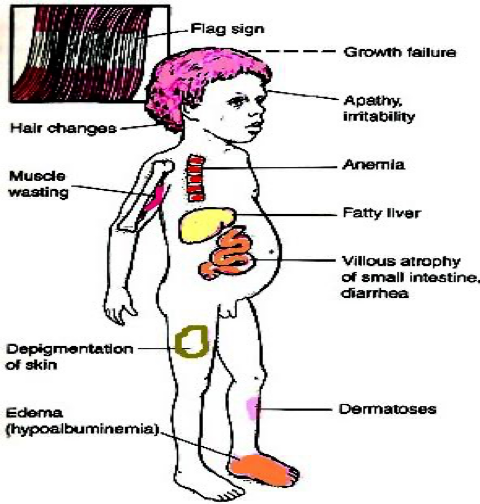Kwashiorkor
Definition:
It is a form of malnutrition characterized by a slow rate of growth due to deficient protein intake, high CHO diet, and vitamins & minerals deficiency (adequate supply of calories).
Incidence:
Commonly in toddlers between the age of 1-3 years, following or with weaning.
Etiology
- Unbalanced diet: of protein, CHO
- Improper weaning: during and post-weaning period
- Faulty management of marasmic baby
- Ignorance poverty due to lack of basic health education
- Precipitating factors: acute infection with measles, diarrhea, and malaria, parasitic infestations
Assessment
 Doll face
Doll face
1. Essential Features (Cardinal Manifestation)
-
Growth retardation: Weight is diminished (60-80%) of expected Z
-
Edema: Due to hypoproteinemia. It starts in the feet and lower parts of the legs, then becomes generalized edema. The cheeks become bulky, pale, waxy in appearance (doll-like cheeks).
-
Diminished muscle fat ratio: Generalized muscle wasting with subcutaneous fat
-
Fatty liver: Detected by liver biopsy
-
Mental changes: The infant has apathy Z, never smiles, looks sad, and his cry is weak
2. Early Features (Usual Manifestation)
- Hair changes: The hair is sparse, dys pigmentation (reddish or greyish), atrophic, easily pickable
- G.I.T Manifestations: Anorexia, vomiting in severe cases, diarrhea
3. Occasional or Variable Features
- Vitamins and minerals deficiency: Vit. D, A, C, minerals like iron, zinc, Mg
- Hepatomegaly
- Skin changes: Dermatitis in areas due to pigmentation, napkin dermatitis, petechiae over the abdomen, fissures, ulceration
- Poor resistance and liability to infections

Complications of Kwashiorkor
- CVS: Hypovolemic shock, HF due to anemia and infection
- GIT: Atrophy of the pancreas with subsequent glucose intolerance, atrophy of the mucosa of the small intestine, lactase deficiency, ileus, bacterial overgrowth (septicemia), gastroenteritis, fatty liver
- Loss of immune function, antioxidant function, subsequent infections, UTI, septic shock, and death. Both bacterial and fungal
- Endocrinopathies: Insulin levels are decreased; growth hormone is increased, but insulin-like growth factor levels are reduced. This leads to insulin intolerance. Hypoglycemia
- Metabolic disturbances and hypothermia, acidosis
- Impaired cellular functions, including endothelial dysfunction
- Electrolyte abnormalities
- Hemorrhagic tendency, purpura
Investigations for Kwashiorkor
- Blood analysis: Albumin < 2.5 gm/dl, total protein, amino acids, enzymes (amylase, lipase, alkaline phosphate), glucose (hypoglycemia), potassium (hypokalemia), creatinine blood levels, ABG
- Low pancreatic and intestinal enzymes
- Urine analysis, culture for infection
- Stool analysis for parasites
- Chest X-ray
- Tuberculin test
Treatment of Kwashiorkor
- Food with more proteins and more calories
- Long-term vitamin and mineral supplements
- Calories need to be increased slowly because the patient’s diet lacked any significant nutrition for a long period
- If there is a delay in the treatment, the child might stay with permanent physical and mental disabilities. If the condition is not treated, it might turn fatal.